I have got a system of 8 differential equations that I am trying to solve using deSolve in R.
It just returns NaN after the first few steps and doesn't solve it further.
I tried various differential solvers like lsoda (default), bdf, adams, rk4 etc, but it didn't help.
Here is the sample R code:
library(deSolve)
daero = c(5.29,4.16,2.49,1.53,0.7,0.41,0.21)*10^-4
rho = rep(1.27,7)
dgeo = daero * sqrt(1/rho)
r0 = dgeo/2
Fr = c(0.188,0.297,0.274,0.181,0.032,0.013,0.015)
X0 = Fr*200*10^-6
N0 = X0*(3/(4*3.14*r0^3*rho))
func1 <- function(t,state,parameters){
with(as.list(c(state,parameters)),{
dX1 = -D/((3*X1/(4*3.14*rho[1]*N0[1]))^(1/3))*(N0[1]*4*3.14*
((3*X1/(4*3.14*rho[1]*N0[1]))^(1/3))^2)*(Cs-S/V)
dX2 = -D/((3*X2/(4*3.14*rho[2]*N0[2]))^(1/3))*(N0[2]*4*3.14*
((3*X2/(4*3.14*rho[2]*N0[2]))^(1/3))^2)*(Cs-S/V)
dX3 = -D/((3*X3/(4*3.14*rho[3]*N0[3]))^(1/3))*(N0[3]*4*3.14*
((3*X3/(4*3.14*rho[3]*N0[3]))^(1/3))^2)*(Cs-S/V)
dX4 = -D/((3*X4/(4*3.14*rho[4]*N0[4]))^(1/3))*(N0[4]*4*3.14*
((3*X4/(4*3.14*rho[4]*N0[4]))^(1/3))^2)*(Cs-S/V)
dX5 = -D/((3*X5/(4*3.14*rho[5]*N0[5]))^(1/3))*(N0[5]*4*3.14*
((3*X5/(4*3.14*rho[5]*N0[5]))^(1/3))^2)*(Cs-S/V)
dX6 = -D/((3*X6/(4*3.14*rho[6]*N0[6]))^(1/3))*(N0[6]*4*3.14*
((3*X6/(4*3.14*rho[6]*N0[6]))^(1/3))^2)*(Cs-S/V)
dX7 = -D/((3*X7/(4*3.14*rho[7]*N0[7]))^(1/3))*(N0[7]*4*3.14*
((3*X7/(4*3.14*rho[7]*N0[7]))^(1/3))^2)*(Cs-S/V)
dS = -dX1-dX2-dX3-dX4-dX5-dX6-dX7
list(c(dX1,dX2,dX3,dX4,dX5,dX6,dX7,dS))
})
}
state <- c(X1=X0[1],X2=X0[2],X3=X0[3],X4=X0[4],X5=X0[5],
X6=X0[6],X7=X0[7],S=0)
parameters <- c(D=6.19*60*10^-6,rho=rho,N=N0,Cs=17*10^-6,V=1000)
times <- seq(0,3,by=0.0005)
out <- ode(y = state, times = times,func = func1, parms = parameters)
Output:
> out[1:20,]
time X1 X2 X3 X4
0.0000 3.760000e-05 5.940000e-05 5.480000e-05 3.620000e-05
0.0005 3.759491e-05 5.938700e-05 5.476652e-05 3.614143e-05
0.0010 3.758982e-05 5.937400e-05 5.473305e-05 3.608290e-05
0.0015 3.758473e-05 5.936100e-05 5.469959e-05 3.602440e-05
0.0020 3.757964e-05 5.934800e-05 5.466613e-05 3.596594e-05
0.0025 3.757455e-05 5.933500e-05 5.463268e-05 3.590750e-05
0.0030 3.756947e-05 5.932201e-05 5.459924e-05 3.584910e-05
0.0035 3.756438e-05 5.930901e-05 5.456581e-05 3.579074e-05
0.0040 3.755929e-05 5.929602e-05 5.453238e-05 3.573240e-05
0.0045 3.755420e-05 5.928303e-05 5.449897e-05 3.567410e-05
0.0050 3.754912e-05 5.927004e-05 5.446556e-05 3.561583e-05
0.0055 3.754403e-05 5.925705e-05 5.443215e-05 3.555760e-05
0.0060 3.753895e-05 5.924406e-05 5.439876e-05 3.549940e-05
0.0065 3.753386e-05 5.923107e-05 5.436537e-05 3.544123e-05
0.0070 3.752878e-05 5.921808e-05 5.433199e-05 3.538310e-05
0.0075 3.752369e-05 5.920510e-05 5.429862e-05 3.532499e-05
0.0080 3.751861e-05 5.919212e-05 5.426525e-05 3.526692e-05
0.0085 3.751352e-05 5.917913e-05 5.423190e-05 3.520889e-05
0.0090 NaN NaN NaN NaN
0.0095 NaN NaN NaN NaN
Problem/Question
I would like the X's be solved at least until they are reduced to 1% of the initial value. But, I see NaN values too early in the simulation. I tried changing the time step size to as low as 0.0005 and as high as 0.5 hr, but I still encounter the same problem.
